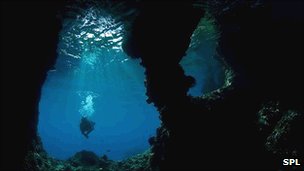
A subterranean river said to be flowing beneath the Amazon region of
The "river" has been widely reported, after a study on it was presented to a Brazilian science meeting last week.
A subterranean river said to be flowing beneath the Amazon region of
The "river" has been widely reported, after a study on it was presented to a Brazilian science meeting last week.
 But the researchers involved told BBC News that water was moving through porous rock at speeds measured in cm, or inches, per year - not flowing.
But the researchers involved told BBC News that water was moving through porous rock at speeds measured in cm, or inches, per year - not flowing.
Another Brazilian expert said the groundwater was known to be very salty.
Valiya Hamza and Elizabeth Tavares Pimentel, from the Brazilian National Observatory, deduced the existence of the "river" by using temperature data from boreholes across the Amazon region.
The holes were dug by the Brazilian oil company Petrobras in the search for new oil and gas fields, and Petrobras has since released its data to the scientific community.
Using mathematical models relating temperature differences to water movement, the scientists inferred that water must be moving downwards through the ground around the holes, and then flowing horizontally at a depth of several km.
They concluded that this movement had to be from West to East, mimicking the mighty Amazon itself.
A true underground river on this scale - 6,000km (4,000 miles) long - would be the longest of its kind in the world by far.
But Professor Hamza told BBC News that it was not a river in the conventional sense.
"We have used the term 'river' in a more generic sense than the popular notion," he said.
In the Amazon, he said, water was transported by three kinds of "river" - the Amazon itself, as water vapour in atmospheric circulation, and as moving groundwater.
"According to the lithologic sequences representative of Amazon [underground sedimentary] basins, the medium is permeable and the flow is through pores... we assume that the medium has enough permeability to allow for significant subsurface flows."
Glacial progress
The total calculated volume of the flow - about 4,000 cubic metres per second - is significant, although just a few percent of the amount of water transported by the Amazon proper.
The underground flow could be confirmed with coastal measurements, scientists suggest
But the speed of movement is even slower than glaciers usually display, never mind rivers.
And whether water really is transported right across the region in this way is disputed by Jorge Figueiredo, a geologist with Petrobras.
"First of all, the word 'river' should be burned from the work - it's not a river whatsoever," he told BBC News.
Water and other fluids could indeed flow through the porous sedimentary rock, he said, but would be unlikely to reach the
"But the main problem is that at depths of 4,000m, there is no possibility that we have fresh water - we have direct data that this water is saline," said Dr Figueiredo.
"My colleagues and I think this work is very arguable - we have a high level of criticism."
End of the affair?
Press reports suggested Professor Hamza was optimistic about confirming his results over the next few years using more direct methods.
But, he said, this was not the case.
"It is well known that geothermal methods are better suited for determining flows with [such small] velocities," he said.
"At lower velocities, experimental techniques may pose considerable difficulties."
It may be possible to examine directly sediments transported into the
The research - Indications of an
The team has named the underground flow the "

 Previous page
Previous page Back to top
Back to top







